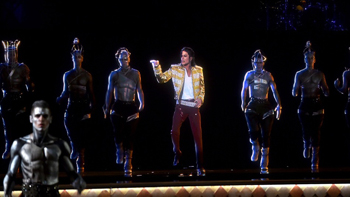Jackson Captivates As 3D Hologram at Billboard Music Awards

Jackson's image, produced by Pulse Entertainment, was seen dancing and singing a new song called "Slave to the Rhythm" at the Billboard Music Awards. Michael Jackson was "alive" and moonwalking his way across the stage during a 3D holographic performance at the Billboard Music Awards on May 18, live from the MGM Grand Hotel in Las Vegas. The Jackson likeness was brought to the stage with technology that led to a copyright infringement lawsuit that nearly stopped the performance altogether. This type of projection effect has been catching on with event producers since it was popularized with a digital performance by deceased rapper Tupac Shakur at the 2012 Coachella music festival.
In the Billboard Music Awards performance, Orlando, Fla.-based Pulse Entertainment brought Michael Jackson to the stage, where he was seen dancing and singing a new song called "Slave to the Rhythm," presumably in an effort to promote Jackson's second posthumous album, Xscape.
Because the resulting image was similar in appearance to patented 3D holographic projection technology that is marketed and controlled by Hologram USA and Musion Das Hologram, the patent-holders filed a lawsuit against the producers of the 2014 Billboard Music Awards, claiming copyright infringement.
A federal judge ruled the Friday before the event (the case was heard the preceding Thursday afternoon) that the Billboard Music Awards producers could use the holographic version of Jackson, rejecting claims made by Hologram USA and Musion Das Hologram. Judge Kent Dawson said he didn't find enough evidence to show the 3D image would violate patents.
Holographic projection technology is able to deliver a lifelike re-creation of an individual that is capable of addressing the audience, moving around stage and even interacting with others with pre-scripted effects. To create the effect of a three-dimensional hologram, an overhead projector throws an image onto a carefully tilted mirror embedded in the stage floor. The moving image is then reflected onto a special screen on stage that makes it appear as if the hologram is physically present.
Hologram USA and Musion Das Hologram obtained the rights to patents relating to holographic performances from visual effects company Digital Domain (responsible for the effects in X-Men: First Class, Transformers: Dark of the Moon and The Curious Case of Benjamin Button, as well as the Tupac Shakur performance at Coachella, with AV Concepts), after the veteran post house filed for Chapter 11 bankruptcy in Delaware in 2012.
The public was not aware of the 3D projected performance at the Billboard Music Awards beforehand, as the show hyped only a "history-making performance." Plans to use the hologram emerged with details of the lawsuit.
Get the TV Tech Newsletter
The professional video industry's #1 source for news, trends and product and tech information. Sign up below.
Attorney Howard Weitzman, who represents Jackson's estate and Billboard Music Awards producer Dick Clark Productions, wrote in an e-mail to USAToday.com, "The court's decision [was] not surprising." He added, "The request to stop this extraordinary Michael Jackson event was ludicrous."
The lawsuit also named John C. Textor, chairman of Pulse Entertainment and former CEO of Digital Domain. Pulse Entertainment staged the Jackson revival at the Billboard Music Awards and was accused of using the hologram techniques without a proper license. Textor would not comment publicly on the case.
The plaintiff's attorney, Ryan G. Baker, said his clients were disappointed with the ruling, but the performance went on as planned.
According to CNN.com, the dance moves used in the Billboard Music Awards event were not those of Jackson himself but of a stand-in performer who re-created Jackson's steps for a computer. The computer recorded the motion and integrated it with an image intended to replicate Jackson.
Mark Cuban, owner of the NBA's Dallas Mavericks, tweeted "He's baaaccck!" and included an Instagram video.
There's no doubt the effect was captivating, if a bit synthetic to Jackson fans. A public relations executive tweeted, "Uncomfortable, odd and eerily interesting. Not quite sure what to feel. #MissingMJ"
In March, USAToday.com reported that Hologram USA sued Cirque du Soleil and MGM Resorts International over its show, Michael Jackson ONE at Mandalay Bay Hotel & Casino. The show makes liberal use of 3D holographic images of Jackson. Hologram USA says the show represents an unlicensed use of its technology.
Jackson's performance at the 2104 Billboard Awards isn't the first digital reawakening of an artist since Tupac's virtual comeback. This year, rapper M.I.A. and singer Janelle Monáe both performed private solo concerts in different cities before teaming up at the end of their shows as life-sized 3D projections. Last year, hip-hop group Wu-Tang Clan used a hologram of rapper Ol' Dirty Bastard.
